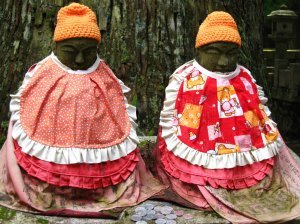Advertisement
Published: February 27th 2008

 Wagayama in Wakayama
Wagayama in Wakayama
A stupid play on words. Wagayama means a spoiled child in Japanese and I took the picture in Wakayama Prefecture. Get it?My trip to the secluded Buddhist community on top of Koyasan was a welcome treat after spending a very hot and hectic summer in central Osaka. I had traveled there on a whim one weekday morning while waiting for a train to take me into Umeda Station in northern Osaka. I couldn’t bear the thought of facing the fervid heat and congested stations that typify the city. Instead, I crossed the overpass and boarded the train heading in the opposite direction, to Koyasan.
Koyasan is the religious center for the Shingon School of Buddhism. It is located in neighboring Wakayama Prefecture and is easily accessible by train from central Osaka. This religious community was formed over a thousand years ago under the guidance of a famous Japanese monk and scholar named Kobo-Daishi. He is revered throughout Japan as the father of this school of thought.
Shingon is a major school of Japanese Buddhism and it is closely related to the other branch of Vajrayana Buddhism that is practiced in Tibet. It is a form of esoteric or tantric Buddhism that is largely made up of elaborate rituals, the chanting of holy mantras, and the practice of various hand gestures
or mudras. Over a hundred temples have flourished and are scattered across the top of this beautiful mountain range. Along with the temples and religious schools hundreds of practicing monks have also flocked to this small Buddhist community and call it their home.
There have been few other places that I’ve visited in Japan that have left such a lasting impression on me as Koyasan. There is something almost magical about the area. Monks slowly meander down the streets in wooden geta while chanting mantras, beautiful timeworn temples are discovered at every turn, colossal cedar trees stretch endlessly into the blue summer sky, and a strange sense of serenity seems to awash the entire community.
I was so captivated by the area that I lost track of time and was forced to spend the night there. There are only a few places to stay on Koyasan besides the shukobo or temple lodgings. They substitute as ryokans and the monks set off certain areas of the building for tourists. It is good way to experience the monastic lifestyle, albeit a very plush one. Most of the monasteries are in the 10,000 yen per person range, which is a bit
high, however, the price is inclusive of two lavish shojin-ryori meals that the monks prepare for you themselves. You are also invited to partake in the temples morning meditation rituals. They wake you at 5am and you are led into a small smoky room where you listen to them chant mantras and perform an elaborate fire ceremony. It was an unforgettable experience.
After watching the morning rituals and eating an amazing breakfast I packed my bags and headed off to the Okunoin Cemetery. Okunion is the largest and most impressive cemetery in Japan. Usually I don’t think of cemeteries as particularly beautiful places but Okunion is an exception. It is home to over 300,000 graves that range from those of famous historical figures to one that marks the final resting place for thousands of white ants, or termites, that an extermination company obviously felt a great sense of regret about. The entire expanse is shaded by hundreds of giant cedar trees and the ground and grave stones are patched over in antiquity with beautiful green moss. It is one of the most tranquil places I have ever been and I spent hours wandering amongst the thousands of graves before
I had to catch my train back into Osaka.
Advertisement
Tot: 0.081s; Tpl: 0.025s; cc: 12; qc: 28; dbt: 0.0264s; 1; m:domysql w:travelblog (10.17.0.13); sld: 1;
; mem: 1.1mb

 Wagayama in Wakayama
Wagayama in Wakayama












